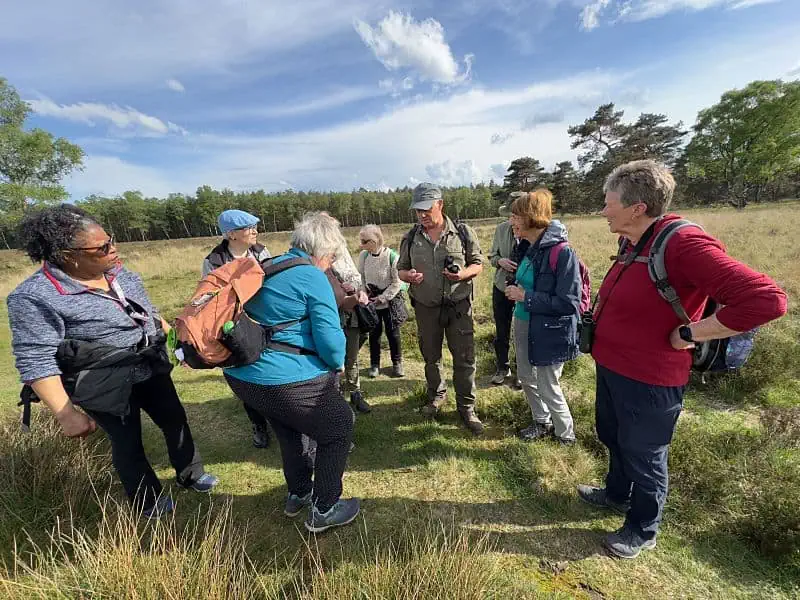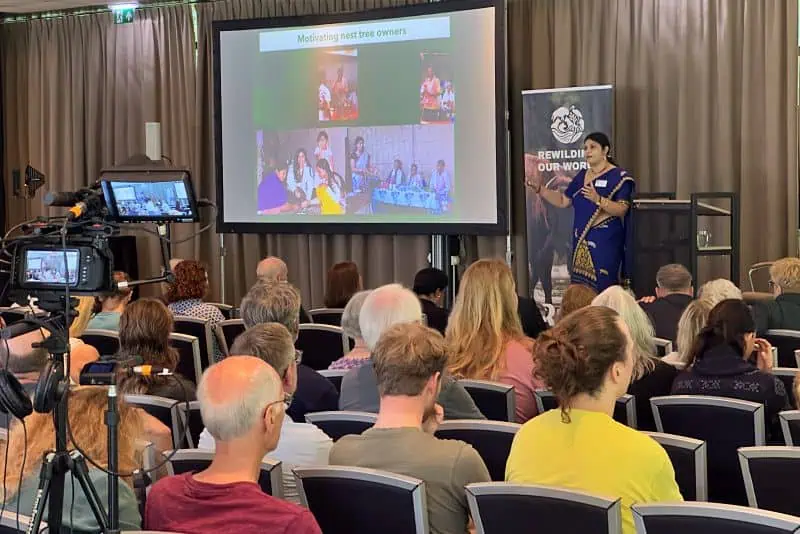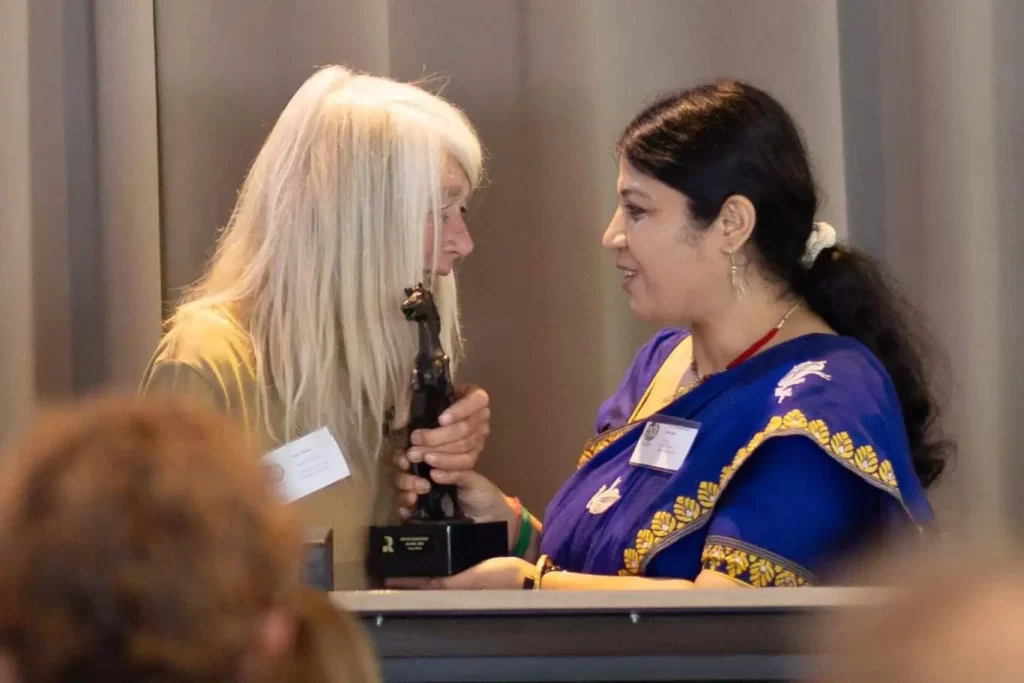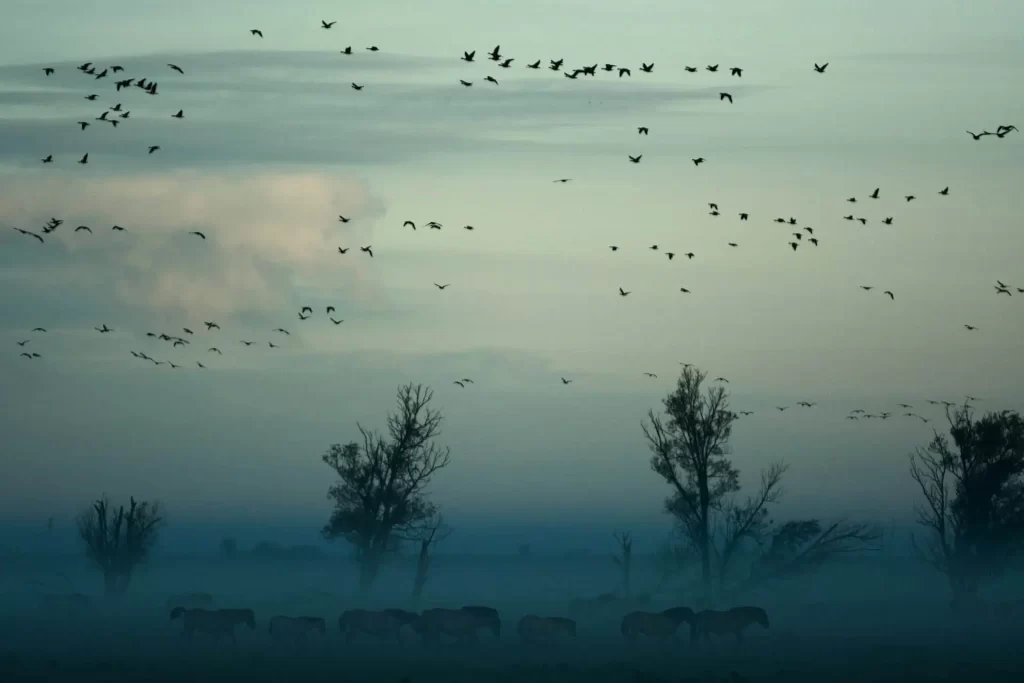Share:
Wolf education for coexistence

The wolf has returned to the Netherlands, sparking both debate and fascination. Often featured in the news, how much do we truly know about this remarkable predator? Join ranger and wolf specialist Marc Wilbers on an excursion to explore how education can unlock understanding and foster coexistence between humans and wolves.
The excursion takes place in the Veluwe, a region where wolves leave their traces. Marc Wilbers will guide you on an informative journey through the landscape, revealing how tracks from wolves and other animals like deer, wild boar, foxes, and ravens tell stories about their behavior. If lucky, you might even catch a rare glimpse of a wolf in the wild.
The excursion answers key questions such as:
• How do wolves live and communicate?
• What do they eat, and how large is their territory?
• How can wolf tracks be identified?
• What should you do if you encounter a wolf?
• What is the ecological role of wolves, and how do they impact the landscape and biodiversity?
• How can humans and wolves coexist peacefully, and what does this mean for livestock farmers?
A key feature of the excursion is a visit to a shepherd, who shares firsthand experiences of keeping sheep in a region with wolves. These stories provide valuable insights into how preventive measures and a deep understanding of wolf behavior can minimize damage.

Lessons learned
Educators, conservationists, policymakers, and others can learn much from this approach to highlighting the presence of wolves in the Netherlands. Key lessons include:
1. Education as a Foundation for Understanding
Knowledge dispels fear and misconceptions. By making information about wolf behavior, ecological roles, and human interaction accessible, people can be better informed and engaged.
2. Storytelling Enhances Insight
Field excursions use tracks and stories to make complex concepts like biodiversity and ecological balance tangible and relatable, sparking curiosity and connection.
3. Empathy Through Shared Experiences
Hearing firsthand accounts from stakeholders, such as shepherds, fosters empathy and mutual understanding, showing how different communities face shared challenges.
4. Encouraging Active Participation
Interactive education engages participants to ask questions, think critically, and contribute to solutions, strengthening their involvement and commitment.
5. Conflict Resolution Through Dialogue
Openly addressing concerns (e.g., livestock safety) alongside opportunities (e.g., ecological benefits) fosters balanced discussions and collaboration.
6. Long-Term Vision Through Education
By educating both youth and adults, sustainable coexistence is built on long-term awareness and behavior change.
Scaling Up and Broadening the Approach
This model of wolf education deserves scaling and adaptation to other regions with wolves or similar species, maintaining its core principles of education, dialogue, and practical insights. Scaling requires trained guides, well-developed educational materials, and collaboration with local stakeholders.
The concept can also broaden to address topics like grazing, rewilding, regenerative agriculture, climate change, or the reintroduction of other species. Tailoring content to each context, alongside greater support from governments, conservation organizations, and communities, will ensure broader impact. Investments in infrastructure, communication campaigns, and long-term programs are critical to achieving this.
De wolf is terug in Nederland en roept veel discussie en verwondering op. Vaak is hij in het nieuws, maar wat weten we nu écht over dit bijzondere roofdier? Ga mee op excursie met boswachter en wolvenspecialist Marc Wilbers en ontdek hoe educatie de sleutel kan zijn tot begrip en co-existentie tussen mens en wolf.
De excursie vindt plaats op de Veluwe, een gebied waar de wolf zijn sporen achterlaat. Marc Wilbers neemt je mee op een leerzame tocht door het landschap en laat je zien hoe sporen van wolven en andere dieren zoals herten, reeën, wilde zwijnen, vossen en raven verhalen vertellen over hun gedrag. Met wat geluk kun je zelfs de wolf in levende lijve spotten, al blijft dat een zeldzaam voorrecht.
Tijdens deze excursie wordt uitgebreid ingegaan op vragen zoals:
- Hoe leven en communiceren wolven?
- Wat eten ze en hoe groot is hun leefgebied?
- Hoe herken je sporen van de wolf?
- Wat moet je doen als je een wolf tegenkomt?
- Wat is de ecologische rol van de wolf en hoe beïnvloedt hij het landschap en de biodiversiteit?
- Hoe kunnen mens en wolf vreedzaam samenleven, en wat betekent dit voor veehouders en hun dieren?
Een belangrijk onderdeel van de excursie is een bezoek aan een schaapsherder, die uit eigen ervaring vertelt over het houden van schapen in een gebied waar wolven voorkomen. Zijn verhalen bieden waardevolle inzichten in hoe preventieve maatregelen en een goed begrip van wolvengedrag schade kunnen voorkomen.

Lessons learned
Educators, natuurorganisaties, beleidsmakers en andere betrokkenen kunnen leren van deze aanpak om de aanwezigheid van de wolf in Nederland te belichten. Hier zijn enkele belangrijke lessen die uit dit voorbeeld gehaald kunnen worden:
1. Educatie als Basis voor Begrip
Het succes van co-existentie hangt af van feitelijke kennis. Angst en misverstanden ontstaan vaak door gebrek aan informatie. Door op een toegankelijke manier uitleg te geven over wolvengedrag, ecologische rol en de interactie met mensen, worden mensen geïnformeerd en betrokken.
Les: Maak educatie een centrale pijler in conflictgevoelige kwesties en zorg dat het gebaseerd is op wetenschappelijke feiten en lokale context.
2. Verhalen Versterken Inzicht
De excursie maakt uitgebreid gebruik van sporen en verhalen in het veld om complexe concepten zoals biodiversiteit en ecologische balans tastbaar te maken. Dit activeert de nieuwsgierigheid en betrokkenheid van deelnemers.
Les: Gebruik verhalen en concrete voorbeelden om abstracte begrippen begrijpelijk en relevant te maken.
3. Empathie Creëren door Ervaringen te Delen
Het bezoek aan de schaapsherder laat zien hoe persoonlijke verhalen van belanghebbenden helpen om empathie en wederzijds begrip te creëren. Mensen horen niet alleen theorie, maar zien hoe andere gemeenschappen omgaan met dezelfde uitdagingen.
Les: Betrek mensen met praktijkervaring (zoals boeren, herders of lokale bewoners) in educatieve programma’s om een breder perspectief te bieden.
4. Actieve Participatie Bevorderen
De excursie moedigt deelnemers aan om vragen te stellen, mee te denken over oplossingen en kritisch te kijken naar hoe de samenleving omgaat met de wolf. Dit stimuleert actieve participatie en betrokkenheid.
Les: Maak educatieve activiteiten interactief en richt je niet alleen op het delen van kennis, maar ook op het betrekken van deelnemers in het vinden van oplossingen.
5. Conflictoplossing Start bij Dialoog
Door aandacht te besteden aan zorgen (zoals schade aan vee) én kansen (zoals ecologische voordelen), laat deze aanpak zien dat co-existentie mogelijk is als er open wordt gepraat over alle perspectieven.
Les: Creëer een veilige ruimte voor dialoog waarin verschillende standpunten en emoties erkend worden, en werk samen aan oplossingen.
6. Langetermijnvisie Door Educatie
Educatie richt zich niet alleen op de huidige situatie, maar bouwt aan bewustwording en gedragsverandering op de lange termijn. Door jongeren en volwassenen te informeren, wordt de basis gelegd voor duurzame co-existentie.
Les: Investeer in continu onderwijsprogramma’s om gedragsverandering en een meer harmonieuze relatie tussen mens en natuur te stimuleren.
Toepassing op Andere Onderwerpen
Deze aanpak kan ook breder worden toegepast op andere onderwerpen zoals duurzame landbouw, klimaatverandering of herintroductie van andere soorten. Het kernprincipe blijft hetzelfde: educatie, dialoog en samenwerking leiden tot oplossingen en begrip.
Opschalen nodig
Dit voorbeeld van wolfeducatie verdient zowel opschaling als verbreding, omdat het een effectieve manier is om co-existentie tussen mens en natuur te bevorderen. Voor opschaling is het nodig om de aanpak naar andere regio’s uit te breiden waar de wolf of vergelijkbare soorten aanwezig zijn, met behoud van de kernprincipes: educatie, dialoog en praktijkgerichte inzichten. Dit vereist meer opgeleide gidsen, ontwikkelde educatiematerialen en samenwerking met lokale belanghebbenden.
Voor verbreding kan het concept toegepast worden op andere thema’s zoals begrazing, rewilding, regeneratieve landbouw, klimaatverandering of de terugkeer van andere dieren. Hiervoor is aanpassing van de inhoud nodig aan de specifieke context, evenals bredere steun vanuit overheden, natuurorganisaties en gemeenschappen. Investeringen in infrastructuur, communicatiecampagnes en langdurige educatieprogramma’s zijn essentieel om een breed draagvlak te creëren en de impact van dergelijke initiatieven te vergroten.






